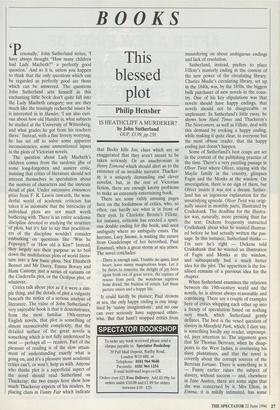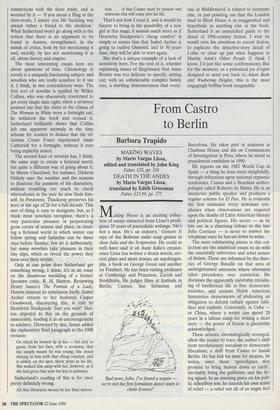BOOKS
This blessed plot
Philip Hensher
IS HEATHCLIFF A MURDERER? by John Sutherland OUP, £3.99, pp.258
Personally,' John Sutherland writes, 'I have always thought "How many children had Lady Macbeth?" a perfectly good question.' And so it is, unless you happen to think that the only questions which can be regarded as perfectly good are those which can be answered. The questions John Sutherland sets himself in this enchanting little book don't quite fall into the Lady Macbeth category; nor are they much like the teasingly recherché issues he is interested in in Hamlet; 'I am also curi- ous about how old Hamlet is, what subjects he studied at the University of Wittenberg, and what grades he got from his teachers there.' Instead, with a fine ferrety worrying, he has set off to solve some apparent inconsistencies, some unmentioned lapses in the plots of Victorian novels.
The question about Lady Macbeth's children comes from the sardonic jibe of some long-forgotten and austere critic, insisting that critics of literature should not interest themselves in speculation about the motives of characters and the intricate detail of plot. Under successive eminences grises from F. R. Leavis onwards, the won- derful world of academic criticism has taken it as axiomatic that the intricacies of individual plots are not much worth bothering with. There is an entire academic discipline devoted to studying the structure of plots, but it's fair to say that practition- ers of the discipline wouldn't consider embarking on questions like 'Was he Popenjoy?' or 'How old is Kim?' Instead, they largely see their purpose as to boil down the multifarious plots of world litera- ture into a few basic plots. Not Elizabeth Bennet and Mr Darcy, Emma Bovary and Hans Castorp; just a series of variants on the Cinderella plot, or the Oedipus plot, or whatever.
Critics talk about plot as if it were a sim- ple thing, and the details of plot a vulgarity beneath the notice of a serious analysis of literature. The value of John Sutherland's very enjoyable book is that it demonstrates, from the most familiar 19th-century English novels, that plot is something of almost inconceivable complexity; that the detailed surface of the great novels is something which is not fully understood by most — perhaps all — readers. Part of the pleasure of reading is of the slow attain- ment of understanding exactly what is going on, and it's a pleasure most academic critics can't, or won't, help us with. Anyone who thinks plot is a superficial aspect of the novel should read Sutherland on Thackeray; the two essays here show how much Thackeray expects of his readers, by placing clues in Vanity Fair which indicate that Becky kills Jos; clues which are so exaggerated that they aren't meant to be taken seriously. Or an anachronism in Henry Esmond which should alert us to the existence of an invisible narrator. Thacker- ay is a uniquely demanding and clever novelist, but, in the rest of Victorian fiction, there are enough knotty problems to make an extremely entertaining book.
There are some richly amusing pages here on the foolishness of critics, who, so often, can hardly see what is in front of their eyes. In Charlotte Bronte's Villette, for instance, criticism has erected a spuri- ous double ending for the book, and seen ambiguity where no ambiguity exists. The heroine, Lucy Snowe, is waiting the return from Guadeloupe of her betrothed, Paul Emanuel, when a great storm at sea arises. The novel concludes:
There is enough said. Trouble no quiet, kind heart; leave sunny imaginations hope. Let it be theirs to conceive the delight of joy born again fresh out of great terror, the rapture of rescue from peril, the wondrous reprieve from dread, the fruition of return. Let them picture union and a happy life.
It could hardly be plainer; Paul drowns at sea, the only happy ending is one imag- ined by 'sunny imaginations', and no one can ever seriously have supposed other- wise. But that hasn't stopped critics from maundering on about ambiguous endings and lack of resolution.
Sutherland, instead, prefers to place Villette's masterly ending in the context of the new power of the circulating library. Charles Mudie's circulating library, set up in the 1840s, was, by the 1850s, the biggest bulk purchaser of new novels in the coun- try. One of his key stipulations was that novels should have happy endings, that novels should not be disagreeable or unpleasant. In Sutherland's little essay, he shows how Hard Times and Thackeray's The Newcomers, as well as Villette, deal with this demand by evoking a happy ending, while making it quite clear, to everyone but the most obtuse reader, that the happy ending just doesn't happen.
Some of Sutherland's best coups are set in the context of the publishing practice of the time. There's a very puzzling passage in Oliver Twist where Oliver, staying with the Maylie family in the country, glimpses Fagin and the Monks at the window. On investigation, there is no sign of them, but Oliver insists it was not a dream. Suther- land has an ingenious explanation for the unsatisfying episode. Oliver Twist was origi- nally issued in monthly parts, illustrated by Cruikshank. The deadline for the illustra- tor was, naturally, more pressing than for the text; Dickens frequently instructed Cruikshank about what he wanted illustrat- ed before he had actually written the pas- sage. In this instance, Sutherland thinks I'm sure he's right — Dickens told Cruikshank that he wanted an illustration of Fagin and Monks at the window, and subsequently had a much better idea for the plot. The apparition is the fos- silised remains of a previous idea for the chapter.
When Sutherland examines the relations between the 19th-century world and the novels, he is almost always reasonable and convincing. There are a couple of examples here of critics whipping each other up into a frenzy of speculation based on nothing very much, which Sutherland gently deflates. The best is the vexed question of slavery in Mansfield Park, which, I dare say, is something hardly any reader, unprompt- ed, pays attention to. The argument goes that Sir Thomas Bertram, when he disap- pears to the West Indies, is overseeing his slave plantations, and that the novel is covertly about the corrupt sources of the Bertram fortune. There is something in it — Fanny earlier raises the subject of slavery, without success — and, elsewhere in Jane Austen, there are some signs that she was concerned by it. Mrs Elton, in Emma, it is mildly intimated, has some connections with the slave trade, and is worried by it — 'if you mean a fling at the slave-trade, I assure you Mr Suckling was always rather a friend to the abolition.' What Sutherland won't go along with is the notion that there is an argument to be found in Austen, strengthened, in the minds of critics, both by her mentioning it and, weirdly, by her not mentioning it at all, about slavery and empire.
The most interesting essays here are about questions of time. Chronology in novels is a uniquely fascinating subject, and novelists who are really sensitive to it use it, I think, in two contradictory ways. The first sort of novelist is typified by Wilkie Collins, who was obsessively concerned to get every single date right; when a reviewer pointed out that the dates at the climax of The Woman in White were a fortnight out, he withdrew the book and revised it. Sutherland brilliantly shows that Collins left one apparent anomaly in the time scheme for readers to deduce that the vil- lainous Count Fosco imprisoned Anne Catherick for a fortnight, without it ever being explicitly stated.
The second kind of novelist has, I think, the same urge to create a fictional world, but quite a different way of going about it. In Martin Chuzzlewit, for instance, Dickens blithely uses the weather and the seasons to illustrate the passions of his characters, without troubling too much to check whereabouts in the year he now finds him- self. In Pendennis, Thackeray preserves his hero at the age of 26 for a full decade. This sort of thing is easy to denigrate, but, as I think most novelists recognise, there's a very particular pleasure in perpetrating gross errors of season and place, in creat- ing a fictional world in which winter can follow spring and Saturday can be three days before Sunday; few do it deliberately, but many novelists take pleasure in their tiny slips, which so reveal the power they have over their worlds.
Only at one point does Sutherland get something wrong, I think; it's in an essay on the disastrous meddling of a former Spectator critic, R. H. Hutton. Reviewing Henry James's The Portrait of a Lady, Hutton misread its conclusion badly. Isabel Archer returns to her husband; Caspar Goodwood, discovering this, is told by Henrietta Stackpoole 'Just you wait!' Hut- ton objected to this on the grounds of immorality, reading it as an encouragement to adultery. Dismayed by this, James added the explanatory final paragraph to the 1908 revision:
On which he looked up at her — but only to guess, from her face, with a revulsion, that she simply meant he was young. She stood shining at him with that cheap comfort, and it added, on the spot, thirty years to his life. She walked him away with her, however, as if she had given him now the key to patience.
Sutherland's reading of this is for once pretty definitely wrong.
All that Henrietta means by her final instruc-
tion . . . is that Caspar must be patient and someone else will come into his life.
That's not how I read it, and it would be bizarre to bring in the possibility of a new girl at this stage; it sounds much more as if Henrietta Stackpoole's 'cheap comfort' is simply to assure him that Isabel Archer is going to outlive Osmond, and in 30 years time, they will be able to start again.
But that's a unique example of a lack of sensitivity here. For the rest of it, whether explaining issues of illegitimacy that Anne Bronte was too delicate to specify, setting out, with an unbelievably complex family tree, a startling demonstration that every- one in Middlemarch is related to everyone else, or just pointing out that the London mud in Bleak House is as exaggerated and hyperbolic as anything else in the book, Sutherland is an unmatched guide to the detail of 19th-century fiction. I wish he would turn his attention to recent fiction, to explicate the detective-story detail of Lolita or clear up just what happens in Martin Amis's Other People (I think I know, I'd just like some confirmation). But for the moment, as a polemical jeu d'esprit designed to send you back to Adam Bede and Wuthering Heights, this is the most engagingly boffiny book imaginable.



























































 Previous page
Previous page